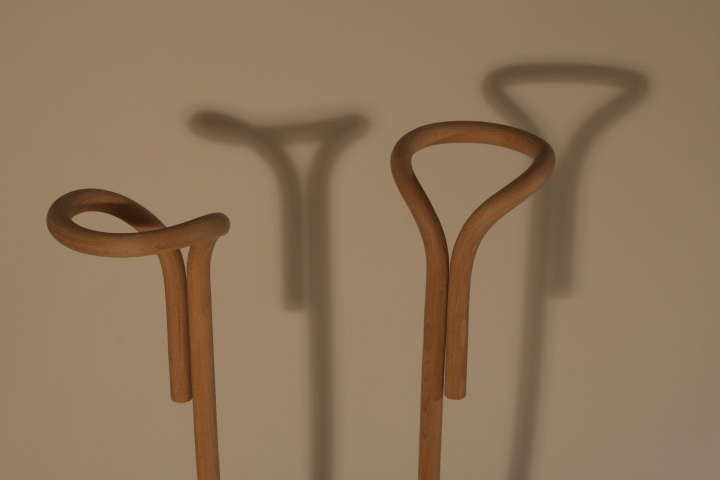Bending Hickory for a Walking Cane
Thoughts on bending thick wood dowels into cane shapes. October 2, 2010
Question
I have a dowel machine coming, and a customer wants me to make hickory walking canes, with the big bend on the holding end. Anyone have info on bending a solid 7/8" dowel into a walking cane?
Forum Responses
(WOODnetWORK)
From Professor Gene Wengert, forum technical advisor:
This is very tricky with a high risk of rejects. You need 25% MC, steam heating and then end pressure when bending. After bending, hold the piece in the bent position until it dries. You will get better results if the grain (annual rings) runs from inside to outside and not side to side in the bent piece. It would be best if you contracted with an experienced bending person rather than try to learn this. This particular bend is very tough to do.
From contributor C:
What is the bend radius? You are increasing your challenge by making a dowel first because you will have a hard time using a backing strap on the round. Another problem with steaming canes is that you have to be able to keep the straight part straight. Support the shaft well so that it doesn't try to move during the drying.
Take a look at this Project Gallery listing to see some of my canes with very tight bends: Bentwood Canes
Don't try to use kiln dried wood. As Dr. Wengert said above, moisture content matters.

Click here for higher quality, full size image
From contributor W:
I have talked at length with Windsor chairmakers and the other trick is to split out the stick blanks from green wood in the log to keep the grain the curve of bend. Then shape the stick after steam bending. The jig needs to hold the entire piece until it is dry. One chairmaker has a pond in back of his shop to keep his logs soaking wet until he needs them. My shepherd's staff has the grain following the entire staff.
From Professor Gene Wengert, forum technical advisor:
Incidentally, when bending such a piece, it is important that the person sawing the blanks split the log first in order to be able to saw parallel to the grain. You do not want any slope of grain.
From contributor J:
Contributor C, the pieces you sell are flexible - how does one get them to freeze once they are in a shape you want?
From contributor C:
Compressed hardwoods are held at about 25% MC, at which point they are very flexible and cold bendable. They stay flexible at that moisture content even with prolonged storage. To fix the shape, bent parts are dried to 7% MC. This is more critical for an unsupported part like a cane. Bent parts need to be dried on the bending form if precise shape control is desired.
From contributor J:
Thanks. I come from a background of bentwood lamination, so bending wood with a high MC is new to me.
From contributor C:
If it were steam bent, the moisture content would be similar (but steam bent parts couldn't make this tight a bend).
From contributor T:
When I made my walking cane it was made out of oak. I soaked the dowel in a trough-shaped container that was wide enough to fit the cane in a bent position. I soaked the cane for a week or two before I tried to bend it. When I was ready to bend it I clamped a piece of wood that was curved with the radius I wanted. The sharper the curve is on the cane, the longer it needs to soak and it takes longer to make the bend.
